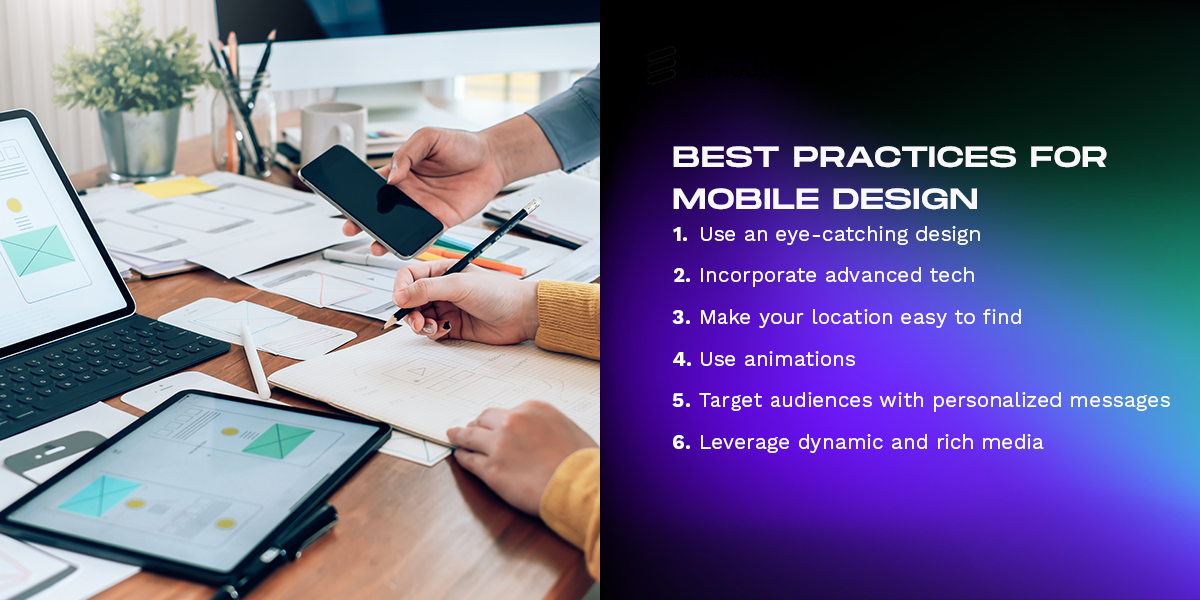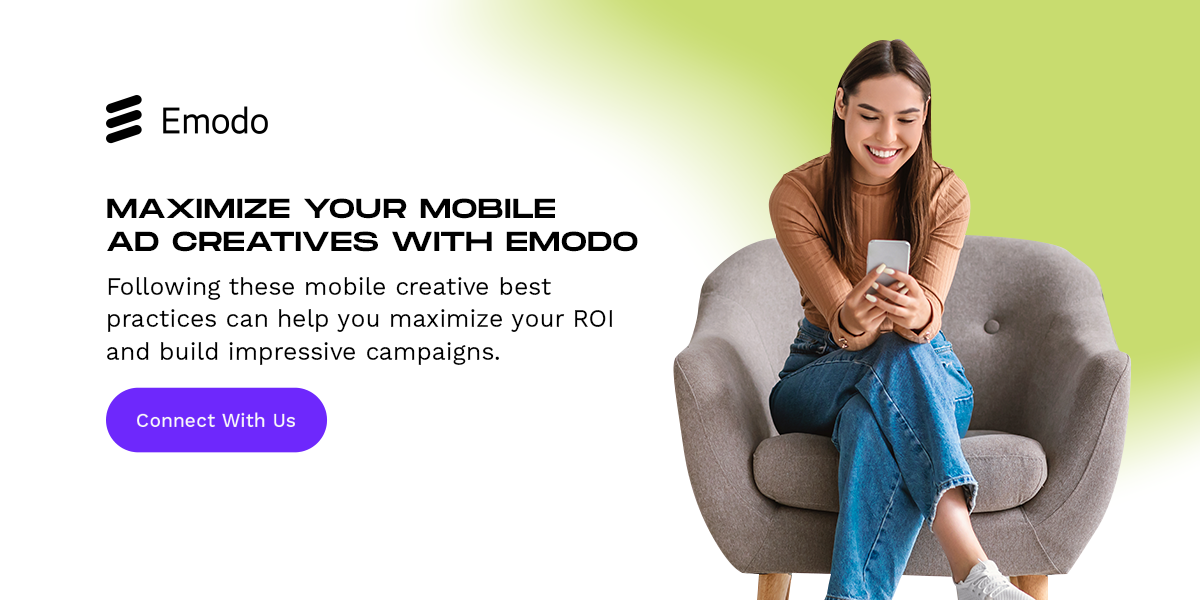Nowadays, people are increasingly spending time immersed in their phones. In January 2022, people used their smartphones for an average of 4.8 hours per day. Mobile is quickly becoming the most effective medium for ad visibility and engagement.
Creative mobile ad design is critical for grabbing and holding viewers’ attention. Mobile ads best practices can help you determine the best way to design beautiful, immersive experiences your viewers will love.

Best practices for mobile design
Optimizing ad campaigns for the platform you’re targeting is essential because mobile and desktop ad environments present different challenges.
- Desktop: The traditional desktop ad-serving sequence depends heavily on the client browser or application to load the ad. While this sequence can affect loading speed, desktop users are more likely to have a high-speed connection that allows the ad to load quickly.
- Mobile: Because mobile users often suffer slower connections, ads take more time to appear. Viewers may become impatient and abandon slow-loading ads before they finish.
Following these best design practices for mobile advertising will help you put your ads in the best position to drive engagement and interactivity.
1. Use an eye-catching design
Creative is critical in advertising. But branding aesthetics involve more than choosing the perfect color scheme or font family.
That’s where visual narrative comes in. A good story draws a viewer’s attention better than anything else.
Visual narrative is a story told through graphics and video. The core elements of visual narrative include the following.
- Entertainment: Immediately grab your audience’s interest by providing an engaging introduction, or “hook.”
- Micro-interactions: Small interactions help users feel as though they are in control of the experience, which allows them to immerse themselves more fully in the story. Even the most seemingly trivial elements can provide a more engaging experience.
- Tension: Make the viewer interested in the story, so they keep consuming the ad and absorb the message you’re trying to send.
- Education: Provide the viewer with engaging information to make them want to learn more about the topic.
- Call to action: Make it evident what action the audience should take once they finish the story. For example, you could prompt viewers to fill out an online contact form or browse your product page.
2. Incorporate advanced tech
Want to leave a big impression? Advanced technologies like augmented reality can help you create more immersive ad experiences. AR is uniquely ideal for mobile ads because it enables you to take advantage of device features like cameras and location data.
The potential applications for AR in mobile advertising are endless. For example, a makeup line could show how their products look by superimposing virtual cosmetics onto the viewer through the front-facing camera. Or, a tech company could allow users to test their newest product in real time through a series of AR demos.
3. Make your location easy to find
Most mobile apps use geolocation technology in some way. Combining this function with your mobile ad creative has the following benefits.
- Improves personalization: Adding location data to your creative allows you to target people in your area, ensuring you are serving ads relevant to your audience. This tactic can boost response rates and generate higher engagement.
- Encourages in-person visits: When customers are near a store that has something they need, they can quickly stop in without disrupting their whole day. Providing nearby users with directions to your location helps them find your business so they can take action.
Combining a dynamic distance overlay with your branded messaging is an excellent way to incorporate location data into your creative.
Here’s an example. Consider a viewer on a business trip. They’re trying to figure out where to eat between meetings. A quick-service restaurant near their hotel could serve them an ad reading, “Lunch is just a few blocks away.” If you plan to take this approach, make your location font as large as possible so it’s legible at a glance.
4. Use animations
Most mobile ads are static images. Adding a simple GIF animation, or leveraging creative formats that use animated effects or encourage interactivity (like add-to-cart functionality), create an eye-catching ad that grabs the user’s attention and holds it.
Even the subtlest GIF can drive better results. For example, a shoe company might create a GIF that rotates through all their available flip-flops for a summer ad campaign. It’s interesting enough to make users stop scrolling and watch to see which shoes appear next.
5. Target audiences with personalized messages
Personalization is a vital element of creative mobile advertising. A whopping 91% of consumers say they’re more likely to buy from brands that serve them relevant ads. And 62% of consumers say they would drop a brand that delivered generic content.
Tracking technologies are disappearing in mobile and desktop environments. Marketers and advertisers who rely on third-party data will need to find new ways to gain insights about their audiences.
Working with companies that can help you target your consumers accurately and at scale, even without IDs, will be essential moving forward.
6. Leverage dynamic and rich media
Rich media ads, also known as multimedia ads, combine multiple interactive elements to engage users and encourage interaction. According to research from eMarketer, rich media ads far outperform standard banner ads by an incredible 267%.
With so many possible combinations of media components, rich media offers remarkable flexibility for advertisers. Here are some examples of successful applications for rich media ads.
- Interstitial ads: An interstitial ad is a full-screen interactive ad that blends images, audio, text and videos to create a captivating experience. Due to their size and interactivity, interstitial ads improve the chances that your target audience will see and understand your message.
- Expandable ads: These ads are a hybrid between the standard banner advertisement and an interstitial rich media ad. Typically, they appear as banners users can tap on to expand for the full experience. This format is less intrusive than others, encouraging the viewer to take the first step in engagement.
- In-ad CTA: Incorporate an actionable CTA in your ad so viewers can reach out for more information without having to leave the ad. This feature is especially convenient for mobile because it allows you to target users who are constantly on the move.

Maximize your mobile ad creatives with Emodo
Following these mobile creative best practices can help you maximize your ROI and build impressive campaigns.
At Emodo, we believe in creative you can feel. Our immersive, dynamic experiences are richer and personalized to deliver relevant, rewarding and memorable advertising for all. Emodo Adapt, our proprietary native solution, and our AR capabilities allow you to build ads that drive engagement and increase conversions.
What’s more, the Emodo Suite offers tap-to-map and shoppable ads to drive impact for your mobile campaigns. Trust our audience targeting and contextual solutions to help you prepare for the impending death of cookies and mobile ad IDs. Deepen your reach, without losing accuracy and the ability to personalize, with Emodo. Contact us today to get started.
MORE LIKE THIS


